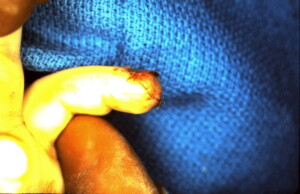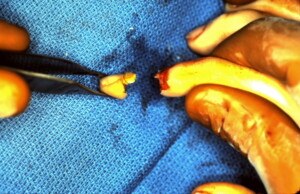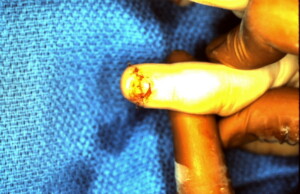Fingertip Amputation Replaced as a Composite Graft
Fingertip amputations are very common in the pediatric population. Caught in closing doors, drawers and similar places. If there is not significant bone involvement replacement as a composite graft is a reasonable option since it may survive as a composite graft. At worst if the graft becomes necrotic it can serve as a biologic dressing while the wound undergoes healing by secondary intention. The only reason to debride a failing graft in my opinion is if there is evidence of infection. If the graft does not take you are simply in the same situation you were in if you did not have the amputated part to replace and can begin going up the reconstructive ladder as you would typically do. Composite grafts are more likely to take in the pediatric population than adults. In adults if there is no bone exposure the amputated part can be defatted and applied as a full thickness skin graft with reasonable success.
 Left ring finger fingertip amputation with nail plate avulsion. There was no bone involvement.
Left ring finger fingertip amputation with nail plate avulsion. There was no bone involvement.
 The undersurface of the graft is being shown.
The undersurface of the graft is being shown.
 The graft has been applied and sutured into place. Lateral view
The graft has been applied and sutured into place. Lateral view
 This is a larger fingertip amputation of the right index finger which involved the distal tuft of the distal phalanx.
This is a larger fingertip amputation of the right index finger which involved the distal tuft of the distal phalanx.
 Lateral view of the larger composite graft.
Lateral view of the larger composite graft.
 The bone from the composite graft must be removed to increase chances of graft take. It is unlikely that a bony union would be achieved.
The bone from the composite graft must be removed to increase chances of graft take. It is unlikely that a bony union would be achieved.
Both of these Composite grafts went on to heal successfully.




